Dear visitor,
The Armenian Genocide Museum-Institute will be closed from December 31 till January 3, 2022.
Sincerely,
The Armenian Genocide Museum-Institute Foundation

French Presidential Candidate and President of the Central Region Île-de-France Valerie Pécresse visits Armenian Genocide Memorial
21.12.2021
The delegation led by the President of the Central Region Île-de-France, French presidential candidate Valerie Pécresse, who arrived in Armenia on a working visit, visited the Armenian Genocide Memorial on December 21.
The guests were welcomed by the Director for the Armenian Genocide Museum-Institute Harutyun Marutyan, who presented the history of the creation of the Memorial.
The French guests put flowers at the Eternal Fire and honored the memory of the innocent martyrs with a minute of silence.

Director for Eastern Europe, Southern Caucasus and Central Asia Countries of FRG Federal Foreign Office Matthias Lüttenberg, visited the Armenian Genocide Memorial
14.12.2021
Arriving in Armenia on a working visit, Matthias Lüttenberg, Political Director for Eastern Europe, Russia, the South Caucasus and Central Asia, visited the Armenian Genocide Memorial on December 14.
The guests were welcomed by the Deputy Director for the museum affairs Lusine Abrahamyan, who presented the history of the creation of the Memorial.
The members of the delegation put flowers at the Eternal Fire and honored the memory of the innocent martyrs with a minute of silence.

Chairman of the Higher Presidential Committee of Churches Affairs in Palestine; Muin Elias Youssef Khoury visited Armenian Genocide Memorial
14.12.2021
Members of the delegation led by the Chairman of the Higher Presidential Committee of Churches Affairs in Palestine; Muin Elias Youssef Khoury, who arrived in Armenia on a working visit, visited the Armenian Genocide Memorial on December 12.
The guests were welcomed by the Deputy Director for the museum affairs Lusine Abrahamyan, who presented the history of the creation of the Memorial.
Muin Elias Youssef Khoury laid a wreath at the Genocide Monument, after which members of the accompanying delegation put flowers at the Eternal Fire and honored the memory of the innocent martyrs with a minute of silence.

A Delegation from Auvergne-Rhône-Alpes region in France visits the Armenian Genocide Memorial
08.12.2021
The members of the delegation, led by the first vice president of the Auvergne-Rhône-Alpes region of France Mrs. Stéphanie Pernod, the economic adviser Mrs. Sophie Cruz and the head of the Quebec-France-Francophonie Partnership Mrs. Agnes Hernou, who all arrived in Armenia on a working visit, paid a visit to the Armenian Genocide Memorial on 8 December.
AGMI Director Harutyun Marutyan welcomed the guests and told them the history of the creation of the Memorial. He also related the story of the 3 khachkars placed in Tsitsernakaberd Park dedicated to the memory of the Armenians who perished during the ethnic cleansing of the Armenian population within Azerbaijan at the end of the last century.
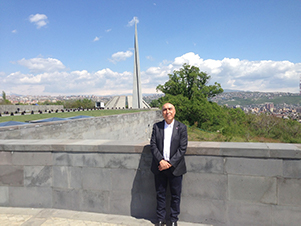
Ali Ertem, president of the “Union Against Genocide” has passed away
08.12.2021
Ali Ertem, a Turkish intellectual and founder and chairman of the “Union Against Genocide” (Soykırım Karşıtları Derneği), who was active in the struggle for the recognition and condemnation of the Armenian Genocide for nearly two decades, died on December 2 in Frankfurt, Germany.
Ali Ertem founded the organization in 1998, visiting Armenia for the first time in that same year to pay tribute to the memory of the innocent victims of the Armenian Genocide.
He would visit Yerevan on April 24 almost every year to lay a wreath on behalf of the union members at the memorial to the victims of the Armenian Genocide. The last time he came to Armenia, with his children, was in 2019.

SAS Donates 130 Academic Books to Armenian Genocide Museum
07.12.2021
As part of its ongoing cooperation with the Armenian Genocide Museum-Institute, the Society for Armenian Studies donated around 130 academic books to the Museum in aiming to strengthen its library collection. The academic books included topics pertaining to the Armenian Genocide, late Ottoman history, comparative genocide, and the Holocaust.
The collection totaled $2,000 and included the latest scholarship published within fields which would otherwise not be accessible to scholars in Armenia. The project was initiated by the SAS a few months ago and included active participation from its members.

Former US Republican senator and presidential candidate Bob Dole, a great friend of Armenians, has passed away
07.12.2021
Former United States senator and presidential candidate Bob (Robert) Dole passed away on December 5, 2021, at the age of 99. He was one of the most active American statesmen defending the interests of Armenians in the United States throughout his political career. He was a member of the Congressional Caucus on Armenians in 1995-1996, advocating the recognition of the Armenian Genocide (1975, 1982, 1984) and for the imposition of an embargo on Turkey (1975, 1977, 1979, 1983) and bills for the provision of financial assistance to Armenia (1992-1996) and Nagorno Karabakh (1994-1996). He participated in the drafting of Resolution 907, passed by Congress in 1993, which prohibited the US government from “directly supporting Azerbaijan as the US President was not convinced and did not inform Congress that the Azerbaijani government was taking obvious steps to lift the [Armenian] blockade or other use of force against Armenia and Nagorno Karabakh.”
Bob Dole’s approaches to the Armenians and the Armenian Genocide were greatly influenced by his personal physician, Hambar (Hambardzum) Kelikyan who, having survived the Hadjin massacres in 1920, moved to Chicago, where he received his medical education.

The AGMI library has been enriched with books from the personal library of the well-known genocide scholar Israel Charny
01.12.2021
The library of the Armenian Genocide Museum-Institute Foundation has been enriched with more than 50 books from the personal library of Israel Charny, a Jewish genocide scholar and editor of the Encyclopedia of Genocide, which were brought from France to Armenia by Dr. Vigen Karapetyan. The books were passed to him by the Honorary Consul of the Republic of Armenia in Israel Tsolak Momjyan.
It should be recalled that in 2011 Israel Charny was awarded the Republic of Armenia’s Presidential Prize “in recognition of decades of academic work in support of research on the recognition of the Armenian Genocide and genocide denial.”
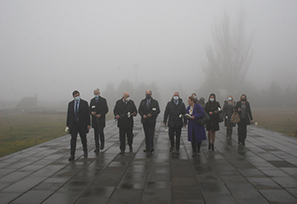
Deputies of the Greek Parliament visited the Armenian Genocide Memorial
30.11.2021
The delegation headed by Dimitrios Markopoulos, Member of the Greek Parliament, Head of the Greece-Armenia Parliamentary Friendship Group, who arrived in Armenia on a working visit, visited the Armenian Genocide Memorial on November 30, accompanied by the Chairman of the RA NA Standing Committee on European Integration Arman Yeghoyan.
The guests were welcomed by AGMI Director Harutyun Marutyan, who presented them with the history of the creation of the Memorial. He also told them the story of 3 khachkars placed in Tsitsernakaberd Park, which are dedicated to the memory of the Armenians who perished during the ethnic cleansing of the Armenian population within Azerbaijan at the end of the last century.

President and co-Chief Executive Officer of Synopsys Dr. Chi Foon Chan visited the Armenian Genocide Memorial
20.11.2021
President and co-Chief Executive Officer of Synopsys Dr. Chi Foon Chan visited the Armenian Genocide Memorial on 19 November.
The guests were welcomed by AGMI Director Harutyun Marutyan, who presented to the guests the history of the creation of the Memorial.
Near the Eternal Fire of the Genocide Memorial, Mr. Chi Foon Chan honored the memory of the innocent martyrs with a minute of silence.

International Journal of Armenian Genocide Studies, 2021 (1)
18.11.2021
Read the following articles and reviews in the latest issue of the International Journal of Armenian Genocide Studies, published by the Armenian Genocide Museum-Institute Foundation:
• Robert Tatoyan, The Issues of the Number of Western Armenians and Ethnic Composition of the Population of Western Armenia at Paris Peace Conference (1919-1920)
• Meline Mesropyan, Diana Apcar’s Search for an Armenian Protectorate: Hope and Disappointment
• Shushan Khachatryan, Halide Edip and the Turkifi cation of Armenian Children: Enigmas, Problems and Questions
• Joceline Chabot, Sylvia Kasparian, “On the High Seas with no Place to Land”: The Smyrnaean Inferno and Humanitarian Aid to Armenian and Greek Refugees from Turkey (1922-1923).

Delegation led by the Deputy Speaker of the Lithuanian Parliament visited the Armenian Genocide Memorial
17.11.2021
The delegation led by the Deputy Speaker of the Lithuanian Parliament Andrius Mazuronis, who arrived in Armenia to take part in the events dedicated to the 30th anniversary of the establishment of diplomatic relations between Armenia and Lithuania, visited the Armenian Genocide Memorial, accompanied by the Ambassador Extraordinary and Plenipotentiary of Lithuania to the Republic of Armenia Mrs. Inga Stanytė-Toločkienė and Deputy of the National Assembly of the Republic of Armenia Anush Beghloyan.
The guests were welcomed by AGMI Director Harutyun Marutyan, who presented to the guests the history of the creation of the Memorial. Dr. Marutyan also told the guests the story of three khachkars placed in Tsitsernakaberd Park, which are dedicated to the memory of the Armenians who perished during the ethnic cleansing of the Armenian population within Azerbaijan at the end of the last century.
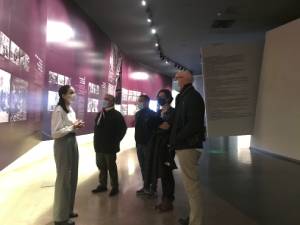
French deputies visited the Armenian Genocide Memorial
16.11.2021
Members of the France-Armenia Friendship Group of the French National Assembly, who arrived in Armenia on a working visit, visited the Armenian Genocide Museum on November 14.
They toured the Armenian Genocide Museum, saw with permanent and temporary exhibitions.

CALL FOR PAPERS
09.11.2021
Conference Title: Challenges of Armenian Genocide Education in the 21st Century
Date: April 20-22, 2022
Location: Armenian Genocide Museum-Institute Foundation, Yerevan, Republic of Armenia
Conference organizer: Armenian Genocide Museum-Institute Foundation
Teaching about genocide, other crimes against humanity and human rights violations are emotionally and intellectually demanding. Even though the work is so complex, its importance has grown in the 21st century, as teaching about genocide is an important means of prevention.

President of the Russian Academy of Sciences Aleksander Sergeev visited the Armenian Genocide Memorial
06.11.2021
On November 5, President of the Russian Academy of Sciences, Aleksander Sergeev, visited the Armenian Genocide Memorial accompanied by President of the National Academy of Sciences of the Republic of Armenia, Ashot Saghyan, and Director of the Institute of History, NAS RA, Ashot Melkonyan.
The guests were welcomed by Deputy Director for Scientific Affairs of the Armenian Genocide Museum-Institute Edita Gzoyan, who presented to the guests the history of the creation of the Memorial.

Representatives of notary chambers of the Russian Federation and Belarus visit the Armenian Genocide Memorial
06.11.2021
Representatives of the Notary Chambers of the Russian Federation and Belarus, who arrived in Armenia on a working visit, visited the Armenian Genocide Memorial, on November 5.
The guests were welcomed by Deputy Director for Scientific Affairs of the Armenian Genocide Museum-Institute Edita Gzoyan. The story of the creation of the memorial was presented by the guide of the Armenian Genocide Museum Lusine Tunyan.

The President of the Constitutional Court of Georgia Merab Turava visited the Armenian Genocide Memorial
05.11.2021
The delegation led by the President of the Constitutional Court of Georgia Merab Turava, who arrived in Armenia on an official visit, visited the Armenian Genocide Memorial, accompanied by the President of the Constitutional Court of the Republic of Armenia Arman Dilanyan.
The delegation was welcomed by Deputy Director for Scientific Affairs of the Armenian Genocide Museum-Institute Edita Gzoyan, who presented to the guests the history of the creation of the Memorial. Dr. Gzoyan also told the guests the story of three khachkars placed in Tsitsernakaberd Park, which are dedicated to the memory of the Armenians who perished during the ethnic cleansing of the Armenian population within Azerbaijan at the end of the last century.

PACE Monitoring Committee co-rapporteurs on Armenia visit the Armenian Genocide Memorial
05.11.2021
PACE Monitoring Committee co-rapporteurs on Armenia Kimo Kiljunen and Boriana Åberg, who arrived in Armenia on a fact-finding mission, visited the Armenian Genocide Memorial accompanied by the deputies of the Armenian National Assembly, Eduard Aghajanyan and Nazeli Baghdasaryan.
The guests were welcomed by Deputy Director for Scientific Affairs of the Armenian Genocide Museum-Institute Edita Gzoyan, who presented to the guests the history of the creation of the Memorial. Dr. Gzoyan also told the guests the story of three khachkars placed in Tsitsernakaberd Park, which are dedicated to the memory of the Armenians who perished during the ethnic cleansing of the Armenian population within Azerbaijan at the end of the last century.
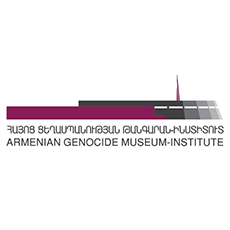
Memorandum of Understanding between AGMI and USC SF
04.11.2021
On October 26, 2021, Memorandum of Understanding (MOU) was signed between the Armenian Genocide Museum-Institute Foundation (AGMI) and the University of Southern California, on behalf of its USC Shoah Foundation – The Institute for Visual History and Education (USC SF). Within the MOU the parties agreed to cooperate to develop collections, research and educational programs that furthers the work of both institutions.
More specifically, AGMI and USC SF will work jointly to develop research programs with affiliated scholars and educational programs using testimony for both AGMI platforms and USC SF IWitness, as well as cooperate on technical infrastructure projects.

Call for Autumn School Applications
Armenian Genocide Museum-Institute Foundation
27.10.2021
Type: Autumn School
Date: November 25, 2021 to November 27, 2021
Location: Yerevan, Armenia
Subject Fields: Genocide Studies, Memory Studies, Human Rights, History, etc.
Deadline: November 10, 2021
The Autumn School will be held in hybrid form. Applicants can attend either in person or online. The language of the Autumn School is English.

Deputy Secretary of the Holy See Edgar Peña Parra visited the Armenian Genocide Memorial
27.10.2021
The delegation led by the Deputy Secretary of State of the Holy See Archbishop Edgar Peña Parra, who arrived in Armenia on an official visit, visited the Armenian Genocide Memorial.
The guests were welcomed by the Deputy Director for the museum affairs Lusine Abrahamyan, who presented the history of the creation of the Memorial.
Archbishop Edgar Peña Parra laid a wreath at the Genocide Monument, after which the accompanying guests put flowers at the Eternal Fire and honored the memory of the innocent martyrs with a minute of silence.

The members of the delegation of the Council of Europe visited the Armenian Genocide Memorial
20.10.2021
The Group of Democracy Rapporteurs of the Committee of Ministers of the Council of Europe, headed by Swedish Ambassador to the Council of Europe Martin Ehnberg, visited the Armenian Genocide Memorial on October 19.
The guests were welcomed by the Deputy Director for the museum affairs Lusine Abrahamyan, who presented the history of the creation of the Memorial.

You may "tour" the Armenian Genocide Museum from anywhere in the world from now on
12.10.2021
Thanks to the work jointly carried out by the Armenian Genocide Museum-Institute and the On Point organisation, it is now possible to make a virtual visit to the Armenian Genocide Museum’s temporary exhibition hall to become acquainted with the titles and objects on display there. You now not only can see but also read the main texts and descriptions relating to the exhibits.
Gayane Movsesyan and Erik Harutyunyan created the virtual exhibition, paying a special tribute to the memory of the victims of the Armenian Genocide through their work. They tried, in this way, to make some episodes of the history of the Armenian Genocide available to people anywhere in the world.

The newly appointed Ambassador of France to Armenia Anne Louyot visited the Armenian Genocide Memorial
06.10.2021
The newly appointed Ambassador of France to Armenia Anne Louyot visited the Armenian Genocide Memorial on 6 October.
The Ambassador was welcomed by AGMI Director Harutyun Marutyan, who presented her with the history of the creation of the Memorial. Mr. Marutyan also told the ambassador the story of 3 khachkars placed in Tsitsernakaberd park, which are dedicated to the memory of the Armenians who perished during the ethnic cleansing of the Armenian population within Azerbaijan at the end of the last century.

Visit of Louise Mushikiwabo, Secretary General of the La Francophonie International Organization, to the Armenian Genocide Memorial
05.10.2021
The delegation, led by Louise Mushikiwabo, the Secretary General of the La Francophonie International Organization, who had arrived in Armenia on a three-day visit, visited the Armenian Genocide Memorial on October 5, accompanied by the Deputy Foreign Minister of the Republic of Armenia Vahe Gevorgyan.
The guests were welcomed by AGMI Director Harutyun Marutyan, who presented them with the history of the creation of the Memorial. He also told them the story of 3 khachkars placed in Tsitsernakaberd Park, which are dedicated to the memory of the Armenians who perished during the ethnic cleansing of the Armenian population within Azerbaijan at the end of the last century.

AGMI Director Harutyun Marutyan awarded Ara Stepan Melkonian with the ′′James Bryce′′ memorial medal
29.09.2021
AGMI Director Harutyun Marutyan awarded Ara Stepan Melkonian, an independent researcher living in Great Britain, with the ′′James Bryce′′ memorial medal on September 22nd.
Mr Melkonian has been assisting the “Armenian Genocide Museum-Institute” Foundation for about three years by selflessly carrying out English-language translations and editorial activities. At present Ara Melkonian’s English-language version of two genocide survivors’ published memoirs in the “Armenian Genocide Survivors’ Memoirs” series (No. 4), (Aram Mantashyan’s “Aram could not be Seito”, edited and annotated by AGMI researcher Regina Galusdyan who wrote the preface and Sokrat Mkrtchyan’s “Memoir”, edited and annotated by AGMI researcher Robert Tatoyan, who wrote the preface and the annexes, published as one volume in Yerevan in 2020) is in its final stages prior to publication.

AGMI Director Harutyun Marutyan Awarded the Local History Archive for Gylling and Surroundings, Denmark with the “Aurora Mardiganian” Memorial Medal
25.09.2021
Mogens Højmark, Director of the Local History Archive for Gylling and Surroundings, Denmark, visited the Armenian Genocide Museum-Institute on September 11, 2021.
The cooperation between the Armenian Genocide Museum and the Gylling Archive has a long history. The personal archive of the Danish missionary Karen Jeppe is being preserved at Gylling’s archive.
Since 2011, Mr. Højmark has donated a number of valuable items to the Armenian Genocide Museum - newspapers, photographs, documents that are of primary importance for the study of Karen Jeppe’s activities, the history of the Scandinavian Armenian movement, and the fate of Armenian women and children who survived the Armenian Genocide.
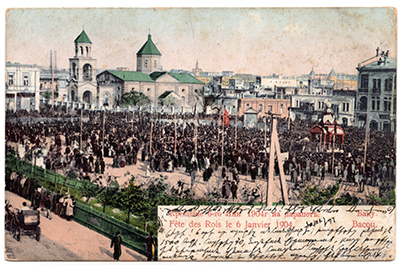
The September 1918 massacres of the Baku Armenians
24.09.2021
The Young Turks’ WWI genocidal policy was not limited to the massacres and forced deportations of western Armenians during 1915-1923. It was also implemented against eastern Armenians between 1918 to 1920, when the Armenians of Baku province were massacred and deported by Turkey and Musavat Azerbaijan. After the failures of the 3rd and 4th Turkish army divisions in the battles of Sardarapat and Bash Aparan in May 1918 and the capture of Gharakilisa, the 2nd Turkish division advanced on Baku on a line through Jajur-Hamamlu-Gharakilisa-Dilijan-Ghazakh-Elizavetpol. The entry of the Turks into Baku was greatly aided by the newly-formed Musavat government of the Democratic Republic of Azerbaijan in Gandzak (headed by M. Fatali Khan-Khoyski).
Turkish-Musavat cooperation became more obvious when the commander-in-chief of the Caucasus Turkish Army, Lieutenant General Nuri Pasha arrived in Gandzak from Mosul on May 27.
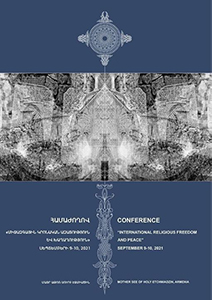
An international conference titled “International Religious Freedom and Peace: Challenges against the spiritual and cultural heritage of Artsakh” was held on 9-10 September 2021
23.09.2021
The international Conference on “International Religious Freedom and Peace” was held at the Ceremony Hall of the Mother See of Holy Etchmiadzin organized on the initiative of His Holiness Garegin II, Supreme Patriarch and Catholicos of All Armenians, the Preaching Center of the Mother See and the Office for Spiritual-Cultural Heritage of Artsakh. The members of the Mother See, representatives of Sister Churches, Christian organizations, scholars and public figures from Armenia and other countries participated in the conference.
The aim of the conference was to bring together religious leaders, clergy, scholars and experts from around the world to discuss the issues and challenges of religious freedom and peace, as well as the dangers posed to the world’s spiritual and cultural heritage during the armed conflict. Hayastan Martirosyan, a junior researcher at the Armenian Genocide Museum-Institute, “Department of the Study of the Oppression of the Armenians of Artsakh, Nakhichevan and Azerbaijan” was among the conference attendees.

Astghik Edigaryan, the Armenian Genocide Museum-Institute Foundation’s senior Russian-language guide, was awarded the Medal of Merit for Labor by the decree of the President of the Republic of Armenia, Armen Sargsyan, on the occasion of the Republic of Armenia’s Independence Day
22.09.2021
Astghik Edigaryan, the Armenian Genocide Museum-Institute Foundation’s senior Russian-language guide, was awarded the Medal of Merit for Labor by the decree of the President of the Republic of Armenia, Armen Sargsyan, on the occasion of the Republic of Armenia’s Independence Day for her long years of dedication and conscientious and productive work.
Astghik Yedigaryan was born on 7 August 1939, in Yerevan. She has been working at the Armenian Genocide Museum since 1996.
Dear visitor,
The museum will be closed on September 21.
Sincerely,
The Armenian Genocide Museum-Institute Foundation

The International Conference titled “At the Crossroads of the Armenian Genocide, the Armenian Claims and the Artsakh Issue: Retrospective Evaluations and Prospects” took place
18.09.2021
The three-day conference organised by the Armenian Genocide Museum-Institute Foundation, the National Academy of Sciences, Yerevan State University and the Society for Armenian Studies (SAS) “At the Crossroads of the Armenian Genocide, the Armenian Claims and the Artsakh Issue: Retrospective Evaluations and Prospects” took place on 16-18 September 2021.
The first day of the conference was held at the Armenian Genocide Museum-Institute, the second and third days at the National Academy of Sciences.

Members of the French delegation visited the Armenian Genocide Memorial
17.09.2021
The delegation of the French Republic that arrived in Armenia on a working visit, visited the Armenian Genocide Memorial on September 17. The delegation was accompanied by the Chairman of the RA National Assembly Standing Committee on European Integration Arman Yeghoyan.
The guests were welcomed by Lusine Abrahamyan, Deputy Director for Museum Affairs of the Armenian Genocide Museum-Institute. The AGMI tour-guide Hasmik Martirosyan presented the history of the memorial to the honorable guests.

THE OPENING OF THE INTERNATIONAL CONFERENCE AND TEMPORARY EXHIBITION AT THE ARMENIAN GENOCIDE MUSEUM-INSTITUTE
16.09.2021
The three-day conference, organized by the Armenian Genocide Museum-Institute Foundation, the National Academy of Sciences, Yerevan State University and the Society for Armenian Studies (SAS) “At the Crossroads of the Armenian Genocide, the Armenian Claims and the Artsakh Issue: Retrospective Evaluations and Prospects” was launched at the Conference Hall of Armenian Genocide Museum-Institute today.
The opening ceremony was followed by the opening of a temporary exhibition, which is thematically the first of its kind and has a special purpose, titled "Tracing Armenian Claims: Ownership Certificates Relating to Individual and Community-Owned Armenian Assets" and was organised by the Armenian Genocide Museum-Institute Foundation and the National Archives of Armenia.

PRESS RELEASE
14.09.2021
A conference organized by the Armenian Genocide Museum-Institute Foundation, the National Academy of Sciences, Yerevan State University and the Society for Armenian Studies (SAS) will take place the solemn opening of the three-day conference entitled “At the Crossroads of the Armenian Genocide, the Armenian Claims and the Artsakh Issue: Retrospective Evaluations and Prospects” at the conference hall of the Armenian Genocide Museum-Institute on September 16, 2010, at 9:30 am. About fifty specialists in genocide and related fields from all over the world will attend the conference.
The opening ceremony will be followed by the opening of a temporary exhibition (bilingual - Armenian and English) entitled "Tracing Armenian Claims: Ownership Certificates Relating to Individual and Community-Owned Armenian Assets" organized by the Armenian Genocide Museum-Institute Foundation and the National Archives of Armenia at the Armenian Genocide Museum at 10:30.

THE STORY OF THE KHACHATRYAN FAMILY OF NORSHEN
26.08.2021
My grandfather survived the Armenian Genocide. His name was Khachik Gevorgi Khachatryan and he was born in 1910 in the village of Norshen, located in the Artske-Aljavaz district of the province of Van. His mother, Gyozal Muradi Lputyan (circa 1882-1957) and sister Mariam (Far'è) Gevorgi Khachatryan (1907-1992) also survived. They later told my grandmother Shushik, my uncles, aunt and father about the horrors they lived through.
In spring 1915, my great-grandfather Gevorg was arrested with other men, taken out of the village, and shot dead. His final farewell was to his wife and he said “Gyozal, forgive me ...,” which my uncle Khachik interpreted as a hug or sign of separation. One of the policemen made Gyozal faint by hitting her on her head with a rifle butt and, when she regained consciousness, she found her husband killed with the other men.
After the police left, the local Kurds began a devilish feast, looting, killing and setting everything on fire. Gyozal’s mother-in-law and her little daughter, blond Zardar were among those Armenians who had been put into a barn and burnt. The little girl was hiding with her mother and other children, but when she saw her grandmother approaching, she came out of hiding place and shouted, “Grandma ...!” and ran to her. The criminals drove the child into the barn with her grandmother with the others and set it on fire.

Uruguay’s Foreign Minister Francisco Bustillo visits the Armenian Genocide memorial complex
16.08.2021
The delegation, led by Uruguay’s Foreign Minister Francisco Bustillo, who was in Armenia on an official visit, visited the Armenian Genocide memorial on August 16 accompanied by Armen Grigoryan, acting Minister of Foreign Affairs of the Republic of Armenia.
The delegation was welcomed by the Director of the Armenian Genocide Museum-Institute Mr. Harutyun Marutyan, who recounted the history of the memorial complex to the guests. Mr. Marutyan also told them the history of the 3 khachkars placed in the grounds of Tsitsernakaberd, dedicated to the memory of the Armenians who died during the ethnic cleansing of the Armenian population in Azerbaijan at the end of the last century.

“SCHOLARS FOR SCHOLARS”: PROFESSOR BARLOW DER MUGRDECHIAN AWARD FOR AGMI RESEARCHERS IS BEING LAUNCHED
13.08.2021
Professor Barlow Der Mugrdechian, Director of Armenian Studies, California State University, Fresno, will be offering annual awards for the best article, monograph, collection of articles, book chapters and other undertakings by the AGMI researchers.
Within this initiative, which was qualified as “Scholars for Scholars” by the AGMI director Harutyun Marutyan, the first Der Mugrdechian Award will be provided for the best article, the best book/memoir, the best collection of articles and best exhibition for 2019-2020 prepared by the AGMI researchers.
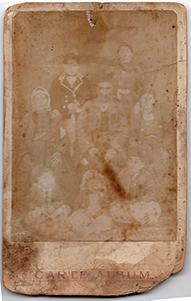
THE STORY OF THE GYOKCHYAN FAMILY OF SIS
12.08.2021
The Gyokchyan family was from the city of Sis in Cilicia. Mihran Gyokchyan (?-1915) was presumably the son of a priest; his wife was named Gohar and they had 5 children: Yepime (?-1932), Lusia (1907-1984), Aram (?-1945), Tefarik (1911-1982) and Nver (1913-1915).
After the murder of her husband, Gohar was displaced with her children (further details are not known); the children ended up in the French orphanage in Mersin, where their mother worked as a cook. While at the orphanage, following the application of eye drops into the children’s eyes, Yepime went blind and Tefarik lost the vision in one eye. The youngest daughter, Nver, died in the same orphanage. In early 1920s, Gohar and her children moved from Mersin to Greece and settled in Kokkina.
Aram Gyokchyan was a member of the Hunchakian Party and at the same time a member of the editorial board of Nor Kyanq, an Armenian-language newspaper. During the German occupation of Greece, Aram was treacherously arrested as a communist sympathizer and shot dead allegedly while trying to escape.

Today is the Assyrian Genocide Victims’ Remembrance Day
07.08.2021
During the First World War, along with the Armenians, the other Christian minorities of the empire, the Ottoman Greeks, the Assyrians, as well as the Yezidis, fell victim to the genocidal policies of the Ottoman state.
The massacres and deportations of the Assyrians, which took place mainly in June-October 1915, resulted in the death of 500-750.000 people according to different calculations.

Cooperation Agreement between the Armenian Genocide Museum-Institute and the Armenian National Institute of Washington Corporation
06.08.2021
On 5 August 2021, Framework Cooperation Agreement was signed between the Armenian Genocide Museum-Institute Foundation (AGMI) and Armenian National Institute of Washington (ANI).
The cooperation between the two institutions has a long history, and the main goal of this agreement is to institutionalize that cooperation and define the main areas of cooperation. The agreement envisages joint use of resources, close cooperation in exhibitions, scientific, and educational fields.

CONTRIBUTING TO ARMENIAN GENOCIDE STUDIES: DR. ROLF HOSFELD
05.08.2021
It was with deep sorrow that we learnt of the untimely death of Dr. Rolf Hosfeld, Ph. D. (1948-2021), Scientific Director of the Johannes Lepsius House-Archive in Potsdam (Lepsiushaus Potsdam), Germany.
With his death we’ve lost an esteemed colleague and a great friend of the Armenian people. His numerous lectures, scientific publications and speeches on the Armenian Genocide have made great contributions to a more comprehensive and detailed presentation of the Armenian Genocide in Germany. His monographs “Operation Nemesis: Germany and the Armenian Genocide” (2005) and “Death in the Desert: The Armenian Genocide” (2015) also found a great response, in their turn, in German scientific and public circles.

THE STORY OF THE BERBERYAN FAMILY OF BOGHAZLIAN
04.08.2021
The Berberyan family was one of the large Armenian families of Boghazlian village in Yozgat province. On the eve of 1915, the population of Boghazlian was comprised of 700 Armenian families and 400 Turkish families. The priest of the local Surb Astvatsatsin Church (built 1865), Father Hakob (Nerses), was the elder of the Berberyan family. As he was born when his father was 80 years old, his birth was considered a gift from God, and the child was destined for religious life. Nerses Berberyan was ordained a priest, receiving the name Hakob, and served in the Surb Astvatsatsin Church.
Father Hakob’s wife was named Narik. They had five children: Gaspar (1890-1925), Anna (1892-1960s), Harutyun (1894-1978), Nazeli (1898-till 1915), Khach’er (1901-1960s). It was Veronica, the daughter of Gaspar and Flora Berberyan (born in 1905 or 1906), who wrote the story of her family.

THEY BELIEVED THAT ONE DAY THEY WOULD RETURN HOME…
31.07.2021
The great tragedy of the Armenian Genocide realised by Turkey’s sinister hand that began in April 1915 did not leave any Armenian family uninvolved. My recent ancestors also became its victims, suffering the consequences of those tragic events.
My great-grandfather, the married priest Rev. Petros, was a well-known, respected and wealthy clergyman in the village of Gharavank in Kaghzvan province. His father’s name was Grigor. About 500 Armenians lived in Gharavank before World War I. My grandfather Samson, a son of Grigor's family, was alas, never seen by any of his grandchildren. My father was named Vardevan (Vardan) and was Samson Petrosyan’s son. My grandfather's family bore the surname Ter-Petrosyan being from a clergyman’s family, but later part of the name, the "Ter" was dropped, probably after they emigrated to Soviet Armenia.

The presentation of the Armenian Genocide Museum-Institute’s "Henry Morgenthau" commemorative medal to a Japanese friend of the Armenian nation
24.07.2021
Mr. Armen Sargsyan, president of the Republic of Armenia, who was on a working visit to Japan, visited the Shibusawa Eiichi Memorial-Foundation established by that well-known Japanese businessman, philanthropist and friend of the Armenian people in Tokyo on July 23. There he met its director, Mr. Koichi Kabayama and Eiichi Shibusawa's great grandson, Masahide Shibusawa.
During his visit, President Sargsyan presented Masahide Shibusawa with the Armenian Genocide Museum-Institute’s "Henry Morgenthau" commemorative medal. It was presented as a token of gratitude to Japanese businessman Eiichi Shibusawa for the establishment of “The Armenian Relief Fund”, which provided significant assistance to Armenians after the Armenian Genocide and for its invaluable contribution to helping people in need.

THE STORY OF THE GEVORGYAN FAMILY FROM KHOTORJUR
21.07.2021
The Gevorgyan family was one of the prominent families living in the Khotorjur village group in the Kiskim district of Erzurum province.
On the eve of the Armenian Genocide there were 978 Armenian houses in 9 quarters of Khotorjur, with a population of 6,906 mostly Catholic Armenians. The Gevorgyans' grandfather, Serob (born in 1824, in Mijintagh, a village in the Khotorjur group), married Almas Kuroghlyan from Khotorjur and they had six children: two daughters, Maruz and Saner and four sons, Harutyun (1860-?), Galust (1865-1926), Hovhannes (1870-1934) and Ispiridon (1874-1939).
Galust Gevorgyan, marrying Vergine, the daughter of brother of the famous Ter Karapet Chakhalyan from Mijintagh, had six sons: Serob (1891-1948), Artashes (1894-1937), Torgom (1898-1982), Yervand (1903-1986), Manas (1903-1964) and Alexan.

THE STORY OF THE MKRTCHYAN FAMILY FROM MEZRE
15.07.2021
The Mkrtchyan family was from the town of Mezre in the Kharberd province of Western Armenia. Tovmas and Yester Mkrtchyan had six children: Yervand, Zenob, Arsen, Araxi, Armine and Alis. The father of the family, Tovmas Mkrtchyan, was a protestant pastor who, from 1896, worked in the service of the British Eastern Consulate in Egypt, which enabled him to avoid arrest and exile.
The deportation order for the Kharberd Armenians was issued in June 1915. Widespread searches, arrests, looting and torture all started under the pretext of finding weapons. Yester and her children managed to find shelter in a local American missionary building.
One day the order for “exile” paper was posted on the Mkrtchyans’ house.

The memoir of Srbuhi Hovakyan, who survived the Armenian Genocide by a miracle, was published in France
13.07.2021
The French National Library published an English and French diary-memoir in April of this year titled "The Earth Alone Can Help Us" written by Srbuhi Hovakyan, who, by the narrowest margin, survived Armenian Genocide. It was edited by Raymond Kevorkian and Maximilian Girard. The presentation of the book took place at the National Library of France on May 11, during which Raymond Kevorkian, Maximilian Girard and Annie Roman, Srbuhi's granddaughter, gave introductory speeches.
Srbuhi Hovakyan's memoir is unique because it was written during the days of the Ottoman Empire's genocide against the Armenians. Eyewitness accounts describe the events of 1915-1918. She is one of the few Armenians who survived one of the most horrific episodes of the Armenian Genocide, the Kemakh gorge massacre.

Memory and social movements; Participation in the international conference
10.07.2021
Suren Manukyan, head of the Department of Comparative Genocide Studies at the Armenian Genocide Museum-Institute participated in the international conference, called: “Memory Studies meets Social Movement Studies– how collective/collected memories have shaped social movements in past and present”, which was organized by the Institute of Social Movements at Bochum Ruhr University.
The conference, which was to take place in Bochum in June 2020, was postponed due to the Covid-19 epidemic. And this year, taking into account the epidemic situation in Germany, it was decided to hold it online on July 18-19, 2021. The conference was an attempt to discuss the possibilities of interdisciplinary research in these two disciplines, to clarify the link between collective memory and "social movements".

Commemoration event at the Armenian Genocide Museum-Institute
08.07.2021
A commemorative event dedicated to the 100th anniversary of the martyrdom of theologian, pedagogue, scientist, linguist and musician Armenag Haigazian took place in the conference hall of the Armenian Genocide Museum-Institute on 7 July. He was arrested by Kemalist forces on 22 May 1921, exiled, became infected with spotted fever on his way to exile and died on 7 July 1921 due to a deliberate delay in treatment.
The Haigazian University in Beirut was so named in his honour.
The commemoration event was attended by graduates of Haigazian University of various years, including former Republic of Armenia Foreign Minister Ara Ayvazyan.

ANNOUNCEMENT
“Teaching the Topic of the Armenian Genocide”
A Summer School Educational Program for Teachers
07.07.2021
The Armenian Genocide Museum-Institute Foundation is organizing a two-day summer school for Armenian history teachers titled “Teaching the Topic of Armenian Genocide” to take place on 20-21 August 2021.
The course may be attended by history teachers of RA secondary and high schools.
The aim of the AGMI course is to train teachers in the use of modern methods of teaching the subject of the Armenian Genocide and to deepen their knowledge of its various aspects, taking into account the psychological features of the subject and current developments in genocide studies.

ANNOUNCMENT CONCERNING DOCTORATE DEGREES
06.07.2021
The Armenian Genocide Museum-Institute Foundation announces admissions to its post-doctoral degree programme for the 2021-2022 academic year. This is in accordance with the Government of the Republic of Armenia’s decision N 760-N of 13 May 2021 titled “On approving the places of admission to post-doctoral degree programmes and their distribution among the higher educational institutions and scientific organizations of the Republic of Armenia for the 2021-2022 academic year”.

A Lecture for European Students
03.07.2021
On 3 July 2021, at the Armenian Genocide Museum-Institute a lecture was delivered by AGMI researcher Regina Galustyan (Educational Programs Department), for nearly thirty students who arrived from different European countries within the framework of a study visit organized by the EU accredited Slovakia Association of Activities, Education and Travel [S.P.A.C.E. - Spolok pre aktivitu, cestovanie edukáciu].
She began her speech by describing the discriminatory policies of the Ottoman Empire and the culture of pre-genocidal violence.

AGMI library has been enriched with new books
02.07.2021
During May-June 2021, the library of the "Armenian Genocide Museum-Institute" Foundation has grown by 500 books, thanks to individual donors, cooperation with the Institute of History of the National Academy of Sciences of the Republic of Armenia and by purchases. Pedagogue and public figure Gevorg Mesrop’s (Gevorg Ter-Mesropyan) personal library stands out in terms of quantity and antiquity and is registered in the AGMI library as a separate collection. It consists of four hundred and thirty books in Armenian and French.
Thanks to cooperation with the Institute of History of the National Academy of Sciences of the Republic of Armenia, the library has also been enriched with about seventy specialized titles published by the Institute of History over the past ten years. In its turn, the AGMI has, under the terms of a reciprocal agreement, given copies its publications to the Institute of History in the last few years.
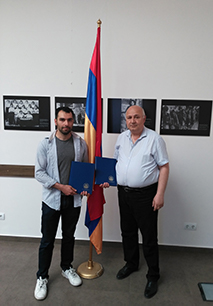
San Francisco Board of Supervisors Declaration on the Armenian Genocide
01.07.2021
The Armenian Genocide Museum-Institute recently received, as a donation, the original statement made by the San Francisco Board of Supervisors on 24 April 2021, with which the San Francisco Board of Supervisors (City Council) announced April 24, 2021 as “Armenian Genocide Remembrance Day” in San Francisco and urged US President Joseph Biden to keep his promise to formally recognize the Armenian Genocide. At the same time, the San Francisco Board of Education was called upon to reaffirm its commitment to teach the historical facts of the Armenian Genocide in San Francisco public schools.
The statement adopted also stated that the 44-day destructive attack by Azerbaijan on Artsakh (Nagorno-Karabakh) on 27 September 2020, with the military-political support of Turkey, was a direct result of the Turkish-Azerbaijani policy of denial of the Armenian Genocide.

A Book by Jakob Künzler was Donated to the Armenian Genocide Museum-Institute by Felix Ziegler
29.06.2021
The book “Dreissig Jahre Dienst im Orient” was donated by its author Jakob Künzler to the Danish missionary Karen Jeppe with his handwriting on the first page: “Der lieben Mitarbeiterin Caren Jeppe überreicht vom Verfasser” (to the dear co-worker Karen Jeppe, handed over by the author). Now the book is part of the AGMI Collection, handed over to us by Mr. Felix Ziegler, successor of Jakob Künzler.
Künzler and Jeppe were working in Urfa during World War I and witnessed the Armenian Genocide, trying to help as much as possible and saving the life of thousands. However Karen Jeppe was so depressed from observing daily the cruelties on helpless wives and children that in 1917 she temporarily departed to Denmark. Jakob Künzler accompanied her half of the way to ensure that she would arrive safely. This travel reinforced their friendship.
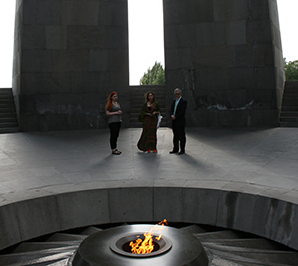
The Visit of the Chargé d’Affaires of the Embassy of the Kingdom of Spain to the Armenian Genocide Memorial
24.06.2021
On 24 June, Mr. Gonzalo Fournier, Chargé d'Affaires of the Embassy of the Kingdom of Spain in Moscow, who arrived in the Republic of Armenia on a working visit, visited the Armenian Genocide Memorial.
Senior guide of the Armenian Genocide Museum Hasmik Martirosyan presented to Mr. Fournier the history of the Genocide Monument.

Memorandum of Understanding between the Armenian Genocide Museum-Institute Foundation and Institute for Informatics and Automation Problems of NAS RA
24.06.2021
On June 2021, a cooperation agreement was signed between the Armenian Genocide Museum-Institute Foundation (AGMI) and the Institute for Informatics and Automation Problems of the RA National Academy of Sciences (IIAP).
The signed agreement creates a basis for the development of joint scientific projects in the fields of scientific, scientific-technical and innovation activities.
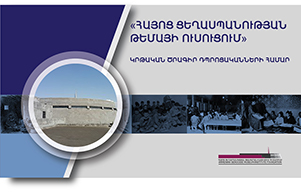
Teaching the Topic of the Armenian Genocide
16.06.2021
The Armenian Genocide Museum-Institute launched a free educational programme titled “Teaching the Topic of the Armenian Genocide” in 2019. It is intended for secondary school (grades VIII-IX) and high school (grades X, XI, XII) students.
The aim of the educational programme is to introduce the history of the Armenian Genocide to schoolchildren with a non-traditional methodology, to make them acquainted with the historical heritage of Western Armenia and the heroic experience of the Armenian people.

Visit of the Acting Deputy Assistant Secretary of State to Armenian Genocide Memorial
11.06.2021
On 10 June, Acting Deputy Assistant Secretary of State for European and Asian Affairs Philip Reeker visited the Armenian Genocide Memorial.
The guests were welcomed by the director of the Armenian Genocide Museum-Institute Harutyun Marutyan, who presented to the guest the history of the construction of the Armenian Genocide Memorial.

A Monograph by Shushan Khachatryan has been published
03.06.2021
The monograph titled The Role of Religion in the Realization of the Armenian Genocide by Dr. Shushan Khachatryan, head of the AGMI Armenian Genocide Victims' Documentation and Data Collection Department, has been published.
The monograph examines the use of religion as a factor and tool in the realization of the Armenian genocide as seen in an historical-religious light.

Announcement on Admission to Doctoral Degree Program
31.05.2021
The Armenian Genocide Museum-Institute announces admissions to Doctoral degree program (in-person) for the current academic year 2021-2022. This is in accordance with decision No. N 799-N of 20 May 2021 made by the Government of the Republic of Armenia and titled “On approving the places of admission to Doctoral degree programs and their distribution among the higher educational institutions and scientific organizations of the Republic of Armenia for the 2021-2022 academic year”.
Dear visitor,
The museum will be closed on May 28.
Sincerely,
The Armenian Genocide Museum-Institute Foundation

The newly appointed Ambassador of Montenegro paid tribute at Armenian Genocide Monument
25.05.2021
The newly appointed Ambassador Extraordinary and Plenipotentiary of Montenegro to the Republic of Armenia (residence in Kyiv) Dragica Ponorac visited the Armenian Genocide Memorial.
The newly appointed Ambassador was welcomed by the director of the Armenian Genocide Museum-Institute Harutyun Marutyan.
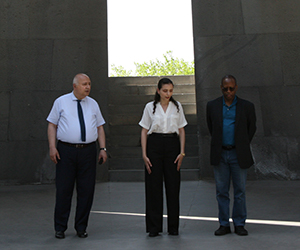
Ambassador of Senegal visits Armenian Genocide Memorial
22.05.2021
On 22 May, Ambassador Extraordinary and Plenipotentiary of the Republic of Senegal to the Republic of Armenia Abdou Salam Diallo (residence in Moscow) visited the Armenian Genocide Memorial Museum.
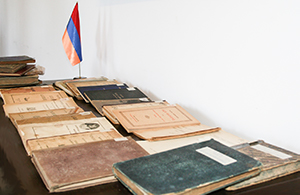
AGMI library was replenished with antique books
21.05.2021
“Armenian Genocide Museum-Institute” Foundation’s library has been replenished with 61 antique books.
The books were donated to the Armenian Genocide Museum-Institute by “Khoren and Shushanik Avetisyan” School.

Commemoration of the victims of the Greek Genocide
20.05.2021
On 19 May, on the anniversary of the Greek Genocide in Pontus, the Ambassador Extraordinary and Plenipotentiary of Greece to Armenia Evangelos Tournakis, state and public figures, AGMI Director Harutyun Marutyan, AGMI staff, and members of the Greek community in Armenia paid tribute to the memory of the victims of the Greek Genocide.

The Prime Minister of Georgia Irakli Garibashvili paid tribute to the memory of the martyrs of the Armenian Genocide
13.05.2021
On 12 May, the Prime Minister of Georgia Irakli Garibashvili, who arrived in Armenia on a working visit, visited the Tsitsernakaberd Memorial accompanied by the Deputy Prime Minister of the Republic of Armenia Tigran Avinyan. Prime Minister laid flowers and paid tribute to the memory of the innocent martyrs.

GEVORG MESROP
12.05.2021
Gevorg Mesrop (Gevorg Ter-Mesropian) was born in Partizak on12 May 1881. He received his primary education in Partizak under the supervision of Abraham Varzhapet, then in the co-educational community school. He has studied at the theological seminary in Jerusalem and, immediately after graduation, began his teaching career. He returned to Partizak in 1904 and was ordinated a deacon at the Armash theological seminary by Patriarch Maghakia Ormanyan.

The Saeima of the Republic of Latvia officially recognized and condemned the Armenian Genocide
06.05.2021
Today, the Latvian parliament issued a special statement officially recognizing and condemning the Armenian Genocide. The announcement particularly states:
“The Saeima of the Republic of Latvia: noting that it is important to commemorate the lost lives of those people who perished in the Armenian genocide organized by the Ottoman Empire authorities – in mass murders and forced deportations which began on April 24, 1915 with the arrests of intellectuals and activists of the Armenian community in the former Constantinople;
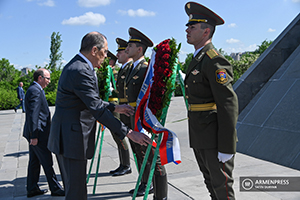
Sergey Lavrov visited the Armenian Genocide Memorial
06.05.2021
On 6 May, the Russian Foreign Minister Sergey Lavrov, who arrived in Armenia on a working visit, visited the Armenian Genocide Memorial accompanied by the Armenian Foreign Minister Ara Ayvazyan.
The guests were welcomed by the Deputy Scientific Director of the Armenian Genocide Museum-Institute Edita Gzoyan. The Foreign Ministers laid a wreath at the memorial to the victims of the Armenian Genocide and laid flowers at the Eternal Fire.

“THE FOUR-YEAR WAR IN THE EAST: THE FRANCO-ARMENIAN PARTNERSHIP DURING THE WAR”
30.04.2021
The Armenian Genocide Museum-Institute hosted a presentation of the memoir titled “The Four-Year War in the East: the Franco-Armenian Partnership During the War” written by naval officer, translator and participant in the rescue of the Armenians of Musa-Ler, Charles-Tiran Tekeian on 30 April, 2021. The author of the explanatory comments and notes concerning the memoir is philologist Karen Aristakesyan.
Dr. Harutyun Marutyan, AGMI Director, in his opening speech, noted the great work Mr. Aritakesyan had carried out and stated: “The work is replete with footnotes. Charles-Tiran Tekeian wrote using the language of an eyewitness, but 100 years later the characters and individual events are unknown to many, therefore the role of the researcher, Mr. Karen Aristakesyan, is of special importance.”

Lithuanian Foreign Minister at the Armenian Genocide Memorial
26.04.2021
On April 26, within the framework of his official visit to Armenia, Lithuanian Foreign Minister Gabrielius Landsbergis visited the Armenian Genocide Memorial Complex.
Delegation headed by Gabrielius Landsbergis was welcomed by AGMI Director Harutyun Marutyan, who presented to the guests the history of the Memorial Complex.

RA Statesmen Paid Tribute to the Memory of the Armenian Genocide Victims
24.04.2021
RA statesmen paid tribute to the memory of the Armenian Genocide victims.
Under the presidency of His Holiness Karekin II, Supreme Patriarch and Catholicos of All Armenians, a memorial service was held for the peace of souls of the Armenian Genocide victims.

Lemkin Scholars Contribute to the Research and Recognition of the Armenian Genocide
22.04.2021
Documents relating to Komitas Vardapet have been found in the National Archives of Spain by Dr. Ivan Gaztañaga, who was a Lemkin scholar at the Armenian Genocide Museum-Institute in 2017. Diplomatic letters found in the archives contain information about the Armenian Genocide. The letters clearly demonstrate that Spain was informed about the massacres and deportations perpetrated against the Armenians by the Ottoman Government. Moreover, Spanish diplomats in Constantinople tried to rescue Komitas Vardapet. One of Komitas Vardapet’s friends also requested the intervention of the King of Spain Alphonse XIII to rescue the composer.

The Opening of the Temporary Exhibition
“Tracing the Families of the Armenian Genocide Survivors”
21.04.2021
The Armenian Genocide Museum-Institute Foundation annual reporting press conference took place on April 21.
AGMI Director Dr. Harutyun Marutyan presented the basic results of the research, scientific-educational and exhibition work carried out by the museum-institute during the previous year.

Book presentation at AGMI
16.04.2021
On April 16, 2021, the presentation of the sixth and seventh volumes of the 10-volume series of titled "ARMENIAN GENOCIDE: PRELUDE AND AFTERMATH. AS REPORTED IN THE U.S. PRESS. THE WASHINGTON POST (1890-1922)") compiled by Father Vahan Ohanian, a member of the Mekhitarist Congregation, and Australian-Armenian researcher Ara Ketibian, took place in the conference hall of the Armenian Genocide Museum-Institute Foundation.
The first five volumes of the multi-volume book cover the leading American dailies (The New York Times, Christian Science Monitor and Boston Daily Globe) with a total of 6696 articles.

PRESS RELEASE
15.04.2021
The opening of the temporary exhibition “Tracing the Families of the Armenian Genocide Survivors” will take place at the temporary exhibition hall of the Armenian Genocide Museum-Institute Foundation on April 21, 2021, at 12:00.
The stories of families of the Armenian Genocide survivors (about thirty), including those of the AGMI staff, will be presented. Original unique items, photos, documents, family relics and other materials from the AGMI collections will accompany the stories. The exhibition will include excerpts from the Armenian Genocide survivors’ video testimonies.
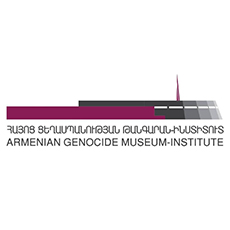
The study group on the issues of Artsakh, Nakhichevan and Azerbaijani Armenians starts working at AGMI
06.04.2021
On February 26, 2021 the Armenian Genocide Museum-Institute opened a competition for three researchers to work in AGMI to study mass violence and genocidal acts perpetrated against the Armenians in Artsakh, Nakhichevan and Armenian-populated areas of Azerbaijan in the 20th and 21st centuries.
Based on the results of the competition held on March 24, three researchers were selected: Naira Sahakyan, Gayane Hovhannisyan and Hayastan Martirosyan.
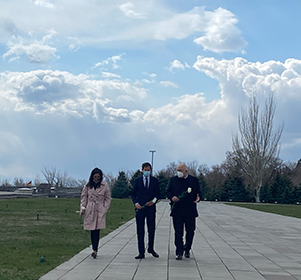
The visit of the French Representative to the European Parliament to the Armenian Genocide Memorial
03.04.2021
On his visit to Armenia, Francois-Xavier Bellamy, the French representative to the European Parliament, visited the Armenian Genocide Memorial on April 3.
Harutyun Marutyan, director of the Armenian Genocide Museum-Institute, briefed the guest on the history of the memorial. François-Xavier Bellamy laid flowers at the eternal fire and honored the memory of the innocent martyrs with a minute of silence. The deputy also visited the Armenian Genocide Museum and made a note in the Memory Book of Honorable Guests.
International Conference Invitation
26.03.2021
Date: September 16-18, 2021
Venues: Conference Hall of the Presidium of National Academy of Sciences of Armenia, Armenian Genocide Museum-Institute conference Hall, Yerevan State University, Matenadaran
The war unleashed by Azerbaijan and its ally Turkey on September 27, 2020 against the Republic of Artsakh and the following ceasefire between Azerbaijan, Armenia and Russia on November 9, had serious negative consequences for the Armenians: The Republic of Artsakh had great territorial losses, a significant number of the Armenians of Artsakh were deprived of the opportunity to live in their homeland and have become refugees.
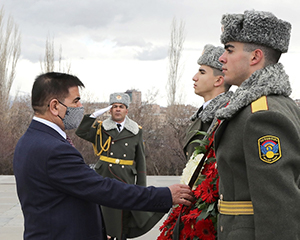
Iraqi Defense Minister at the Armenian Genocide Memorial
25.03.2021
On March 25, the Minister of Defense of the Republic of Iraq Jumaa Inad Saadun Khattab, who arrived in Armenia on an official visit, visited the Armenian Genocide Memorial.
The delegation led by the Minister of Defense of the Republic of Iraq was welcomed by Harutyun Marutyan, Director of the Armenian Genocide Museum-Institute Foundation, who presented the history of the establishment of the Memorial. Minister Jumaa Inad Saadun Khattab laid a wreath at the Memorial to the victims of the Armenian Genocide and flowers at the eternal flame and held a minute of silence in memory of the victims.
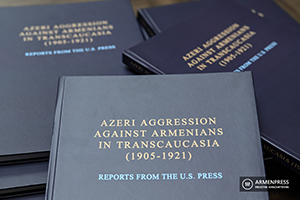
Presentation of the book “Azeri Aggression against Armenians in Transcaucasia (1905-1921): Reports from the U.S. Press” at AGMI
20.03.2021
Ara Ketibian, the Australian-Armenian literary critic and co-author of the multi-volume book “The Armenian Genocide: Prelude and Aftermath. As reported in the U.S. Press”, presented his book “Azeri Aggression against Armenians in Transcaucasia (1905-1921). Reports from the U.S. Press,” in the Armenian Genocide Museum-Institute Foundation conference hall on March 19, 2021.
AGMI Director Harutyun Marutyan welcomed the guests and, in his speech, mentioned that the book has been written during the difficult days of the Second Artsakh War. Its aim was to present the depth of the Artsakh issue and American press coverage of the events of a hundred years ago to the public. He highlighted the author’s extensive work and added that the new book contains a wealth of material for researchers.

The Armenian Genocide Museum-Institutes
Statement
19.03.2021
The Armenian Genocide Museum-Institute strongly condemns another attempt made by Ilham Aliyev, President of Azerbaijan, to distort the ownership of Armenian cultural monuments.
Ilham Aliyev, visiting the occupied territories of the Artsakh Republic including the 12th-century Surb Astvatsatsin (Holy Mother of God) Armenian Church in the village of Tsakuri in the Hadrut region in the last few days, made the following statement:

The “Special Operation”: to Kill Talaat
16.03.2021
A lecture titled “Special Operation: to kill Talaat” took place in the conference hall of the Armenian Genocide Museum-Institute on March 16, presented by AGMI chief registrar and researcher Gohar Khanumyan. It was held on the 100th anniversary of the assassination of Talaat Pasha, one of the main organizers of the Armenian genocide, by Soghomon Tehliryan.
The speaker presented the highly secret decision taken, at the 9th General Assembly of the ARF Dashnaktsutyun in Yerevan in the autumn 1919, to execute the organizers and perpetrators of the Armenian Genocide. The operation was called the “Special Operation,” better known as “Nemesis” and the ARF entrusted it to a special or responsible body set up for the purpose.

The “Special Operation”: to Kill Talaat
15.03.2021
Soghomon Tehliryan was born on April 2, 1896 in the Province of Yerznka (Erzinjan), to the family of Khachatur and Hnazand Tehliryan and was the youngest of four brothers. After studying in his homeland, Soghomon left for Europe to obtain his higher education in Germany.
He was in Serbia, where his father and uncle were staying, when World War I broke out. He went to Tbilisi at the beginning of 1915 with a group of young Armenians living in the Balkans and joined the 1st volunteer unit commanded by General Andranik. In June 1915, Tehliryan entered Van with the Armenian volunteer unit in which he was serving, witnessing the deportation of the local Armenians.
The massacres and deportation of the Armenian population of Yerznka (Erzinjan) began at the beginning of July 1915. Only Armenuhi, his elder brother Misak’s daughter, survived from the 85-member Tehliryan family and was later found among the Kurds. (Soghomon's father Khachatur, brothers Misak, Sedrak and his uncle Oskian who were working in Serbia at that time also survived.

Jacob Künzler, a Swiss Armenophile
08.03.2021
He was a missionary, doctor and nurse, a protestant deacon, eyewitness of the Armenian Genocide and the rescuer and caregiver of thousands of Armenian orphans and widows. All this is about Jacob Künzler, a Swiss. He served in Urfa for about 50 years and later in Ghazir (Lebanon), helping thousands of people, most of whom were Armenians.
Künzler's 28 “pre-Eastern” years were perhaps a long preparatory journey for his future work which was completed with honor. Losing his parents at an early age, he initially worked as a carpenter then, after studying in Basel, became a doctor's assistant and nurse. All this prepared him not only professionally, but also in terms of “humanity.” Künzler knew, from his personal experience, what it meant to be an orphan from an early age.

The new issue of the International Journal of Armenian Genocide Studies has been published
05.03.2021
The new issue of the International Journal of Armenian Genocide Studies has been published!
Please have a look at our newest volume which includes the following articles and reviews:
Jiří Cukr, Marek Jandák
Karel Hansa: the Czechoslovak Traveller in Syria and Lebanon in 1922 and His Work for the Benefit of Armenian Genocide Survivors
Lidia Prisac
Armenian Genocide Survivors: The Strunga Orphanage in Romania
Robert Tatoyan
WWI Armenian Refugees Census Data as a Source for Ottoman Armenian Population Numbers on the Eve of the Armenian Genocide
Tessa Hofmann
A Hundred Years Ago: The Assassination of Mehmet Talaat (15 March 1921) and the Berlin Criminal Proceedings against Soghomon Tehlirian (2/3 June 1921): Background, Context, Effect
Hasmik Tigranyan, Edita Gzoyan
ECHR Retroactive Jurisdiction and the Possibility of Compensations for the Armenian Properties Confiscated during and after the Armenian Genocide: A Brief Analysis
Reviews
Heghar Zeitlian Watenpaugh, The Missing Pages: The Modern Life of a Medieval Manuscript from Genocide to Justice, Stanford, California: Stanford University Press, 2019, 436 pp.
Reviewed by Sato Moughalian
Carolyn J. Dean, The Moral Witness: Trials and Testimony after Genocide, Ithaca: Cornell University Press, 2019, 198 pp.
Reviewed by Asya Darbinyan

Drone Genocide
05.03.2021
It is impossible today to imagine human society without technological development. Innovation and technological advancement bring rapid changes in almost all spheres of human activity, including that of the military. However, the latest technological means, with all their advantages, can pose a great danger both for humanity generally and for certain groups of people, depending on their application. This applies, in particular, to unmanned aerial vehicles or drones that may appear in the hands of terrorist groups or in those of governments that tend to use them for specific targets.
In case of drones, the risk factor is great, as some of them can be created in a short period of time using only limited resources. At the same time, remote control allows drone operators to avoid casualties. One can also already imagine the destabilizing danger posed by state-produced drones equipped with state-of-the-art capabilities.

Prime Minister pays tribute to Sumgait crime victims
28.02.2021
Prime Minister Nikol Pashinyan, Ararat Mirzoyan, Speaker of the National Assembly, and Tigran Avinyan, Deputy Prime Minister, and other high-ranking officials visited the Tsitsernakaberd Memorial to pay tribute to the victims of the Armenian massacre organized in Sumgait on February 27-29, 1988, on the occasion of the 33rd anniversary of that crime.
The Prime Minister laid a wreath and flowers at the memorial to the victims.
Job vacancies for researchers at Armenian Genocide Museum-Institute Foundation
26.02.2021
A competition has been opened for three researchers to work in AGMI to study mass violence and genocidal acts perpetrated against Armenians in Nakhichevan, Armenian-populated areas of Azerbaijan and Artsakh in the 20th and 21st centuries.
Qualifications required:
1. At least a master's degree in one of the following subjects: genocide studies, law, history, oriental studies, or other related fields.

Karapet Gabikyan - 160
24.02.2021
Karapet Gabikyan, a lexicographer and ethnographer, was a remarkable Western Armenian intellectual and community activist. He was born in the Western Armenian city of Sebastia (Sivas) in 1861. He received his education in the school in the city then took up pedagogical work. He wrote many articles and three large-scale works.
When the mass arrests of Armenian intellectuals began in the spring of 1915 and exile became inevitable, Gabikyan voluntarily destroyed his works, notes and literary creations. Having been deported from the city with his family, he lost all of them on the road to exile.
Miraculously having survived, he was exiled to Aleppo in 1919, where he spent the last decade of his life suffering the bitterness and torture of his deportation. He had begun to write his memoirs when he was in Rakka during his deportation.
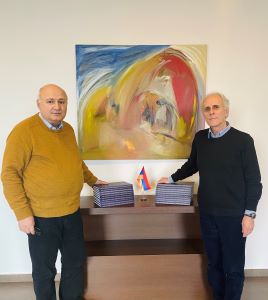
Azeri Aggression Against Armenians in Transcaucasia (1905-1921), Reports from the U.S. Press
19.02.2021
Today, February 19, Australian-Armenian researcher and co-editor of the multi-volume publication “The Armenian Genocide, Prelude and Aftermath, as Reported in the U.S. Press”, Ara Ketibian, visited the Armenian Genocide Museum-Institute.
He presented to the director of AGMI, Mr. Harutyun Marutyan, his new book “Azeri Aggression Against Armenians in Transcaucasia (1905-1921), Reports from the U.S. Press” and donated 100 copies of the book to the AGMI.
The author explained that the principal motivation for compiling this new book was not only the latest aggression by Azeris against the Armenian people, but also his intention to refute the numerous reports circulated in the international media, which emphasized that this conflict was a direct consequence of the collapse of the Soviet Union (1988-1991).

Tokei Maru: The Salvation of Armenians and Greeks in Smyrna
18.02.2021
An event titled “Tokei Maru: the Salvation of Armenian and Greeks in Smyrna” took place in the Armenian Genocide Museum-Institute Foundation conference hall on 18 February 2021. It was one of the events organized on the eve of the 100th anniversary of the Smyrna fire and extermination of the Armenians and Greeks of the city in 1922. It was organized in cooperation with the Armenian-Japanese Armenia-Nippon Scientific-Cultural Union NGO.
The event, which was dedicated to the friendship between the Armenian and Japanese peoples, was attended by Mr. Jun Yamada, Ambassador Extraordinary and Plenipotentiary of Japan to the Republic of Armenia, Second Secretary Mrs. Rika Onodera, Mr. Mnatsakan Safaryan, head of the Asia-Pacific Division of the RA Ministry of Foreign Affairs, Mrs. Maria Lazareva, President of the Union of Greek Communities of Armenia and other guests.
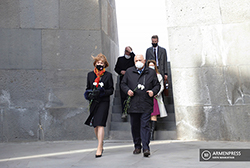
British Minister visits Armenian Genocide Memorial
17.02.2021
On a working visit to Armenia, Wendy Morton, UK Minister for European Neighborhood and the Americas of Foreign, Commonwealth and Development Office, visited the Armenian Genocide Memorial today.
Harutyun Marutyan, director of the Armenian Genocide Museum-Institute Foundation, briefed the guest on the history of the memorial.
Wendy Morton laid a wreath at the memorial to the victims of the Armenian Genocide and flowers at the eternal flame, and honored the memory of the innocent martyrs with a minute of silence.

Presentation of the Armenian Genocide Museum-Institute Foundation’s Publications in 2020
16.02.2021
The presentation of newly published and republished AGMI books took place in the Armenian Genocide Museum-Institute’s conference hall on February 16, 2020.
The presentation was attended by Mr. Jonathan Lacotte , Ambassador Extraordinary and Plenipotentiary of the French Republic to the Republic of Armenia; Ms. Nicola Stanisch, Director of the “Aurora” Humanitarian Initiative; Mr. Harout Nercessian, Armenian Representative of the Armenian Missionary Association of America; Ms. Arpi Vardanyan , Regional Director of the Armenian Assembly of America; as well as other guests.
Mr. Harutyun Marutyan, AGMI Director, greeted the guests with an opening speech, noting that 2020 was a fruitful year for the AGMI in terms of publications, thanks to the expansion of cooperation and the efforts made by AGMI staff.

A Condemnable Act
13.02.2021
There is a unique monument at the intersection of Teryan and Moskovyan streets at Yerevan’s Ring Park. It is dedicated to the memory of the victims of both Armenian and Jewish genocides.
There are hundreds of monuments dedicated to the Armenian Genocide or the Jewish Holocaust in different parts of the world, but this monument, created by Ruben Arucharyan and placed in Yerevan on 27 October 2006, is unique in its harmony. It symbolizes, in fact, not only the great crime of genocide, but also the connection between the memories of both the Armenians and the Jews and the similarity and connection of their fates.
Vandals daubed red paint on this monument on 12 February, leaving inscriptions detailing the names of Israeli-made weapons - Lora, Elbit, Harop, Sandcat, Hermes and Orbiter - that were used by Azerbaijan during the Artsakh war of 2020.

Presentation of “Armenian Genocide Museum-Institute” Foundation’s 2020 Publications
11.02.2021
On 16 February, at 14:00, presentation of eight books of the Armenian Genocide Museum-Institute Foundation published in 2020, will take place at the AGMI Conference Hall.
Last year was unprecedented for AGMI in terms of publications. Eight books were published through the efforts of the staff, including AGMI researcher Narek Poghosyan’s monograph “The Problem of the Armenian Genocide in Raphael Lemkin’s Studies,” collection of articles presented at the conference, funded by the Armenian Missionary Association of America in 2019, “The Rescue of Armenians in the Middle East in 1915-1923: Proceedings of the International Conference,” edited by Harutyun Marutyan and Narine Margaryan.
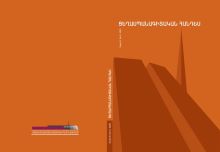
The second issue of Ts’eghaspanagitakan Handes of 2020 has been published
09.02.2021
The second issue of Ts’eghaspanagitakan Handes of 2020 has been published.
As part of the efforts to internationalize the AGMI journals, a separate website for the AGMI publications has been launched: https://agmipublications.asnet.am/. You can find the issues of our journals, as well as other AGMI publications on this page.
AGMI has become a member of the international scientific indexing system Crossref and henceforth our journal articles will have DOIs (Digital Object Identifier).

Zabel Yesayan. for the sake of the armenian orphans
04.02.2021
One of the most prominent Armenian writers who witnessed and narrated the Armenian atrocities, Zabel Yesayan was a publicist, literary critic, public figure and had a great role in the salvation of the Armenian orphans. She went to Cilicia after the Adana massacres of 1909 as a member of the Patriarchate’s second delegation which had the aim of gathering up Armenian orphans and founding an orphanage. Three months later, having partially fulfilled her mission, Yesayan returned to the capital of the Empire in September, 1909. She published her book “In the Ruins” in Constantinople in 1911. This was a “report” of her activities in connection with the Adana massacres and its consequences.
Yesayan was the only woman on the list of the Armenian intellectuals targeted for arrest on April, 1915. She was able to evade arrest and flee to the Caucasus, where she worked with refugees and orphans, documenting their eyewitness accounts of atrocities.

Methodological Seminar
“Armenian Genocide and Jewish Genocide: Relationship Issues”
29.01.2021
On 29 January, methodological seminar “Armenian Genocide and Jewish Genocide: Relationship Issues” took place at the Armenian Genocide Museum-Institute, dedicated to the anniversaries of the liberation of the Auschwitz-Birkenau concentration camp and end of World War II.
A welcome speech was delivered by AGMI Director Harutyun Marutyan, who emphasized the importance of Remembrance Days in preventing such crimes.
The head of the Jewish community of Armenia Rima Varzhapetyan-Feller greeted the audiences and gifted to the AGMI scientific library a book entitled “The Jews of Noah’s Land”.

The Armenian Genocide Museum-Institute Foundation (AGMI) and The Society for Armenian Studies (SAS) Sign An Agreement on Cooperation
28.01.2021
On January 13, 2021 The Armenian Genocide Museum-Institute Foundation (AGMI) signed an Agreement on Cooperation with the Society for Armenian Studies (SAS). The Agreement aims at cooperating on different academic projects that would be beneficial to both parties and advance the field of Armenian Genocide studies. The scope of the cooperation includes, but is not limited to, exchange of mutual information on academic activities carried out by both parties; exchange and loans of books relevant to both parties; exchange of knowledge and expertise with respect to Armenian Genocide; sharing of advice, educational consultation, and research about the Armenian Genocide study and research; cooperation through local and international conferences and symposia to advance the field of genocide studies in general and Armenian Genocide studies in particular; mutual cooperation to educate the general public about the Armenian Genocide; and close cooperation and coordination between the Journal of the Society for Armenian Studies (JSAS) published by the prestigious Brill publishing house and the International Journal of Armenia Genocide Studies (IJAGS), Ts’eghaspanagitakan Handes, both published by the AGMI.

Bodil Biørn - 150
27.01.2021
Bodil Katharine Biørn was born in 27 January 1871, in Kragerø, Norway. She has studied music in Germany and got religious education in Oslo. After working for ten years as a nurse in Norway and Germany, she has joined the Norwegian branch of “Women Missionary Workers” organization.
In winter 1905, Bodil was sent to Germany to the German Hospital in Marash, founded by the German Eastern Mission. Shortly afterwards, she was sent to Mezre to work in a German orphanage. There was a missionary station in Mezre, but Mush had only two Turkish doctors, one of whom was a military doctor. In 1907, Biørn settles in Mush, where she stays for nine years. Here he established an outpatient clinic, which served up to 4,000 visitors a year.
Throughout her stay in Mush, she continued to make home visits to villages in the region, providing medical care to Christians and Muslims alike. Bodil begins to teach medicine, to have assistants and substitutes in case of need. Biørn establishes a school for illiterate women, where the orphanage girls start teaching them reading and writing. For fundraising purposes Biørn had brought with her a camera from Norway to present the life of the locals in the branches of WMW. Her photos were used in reports at Women Missionary Workers’ meetings, and later served as evidence of the genocide.
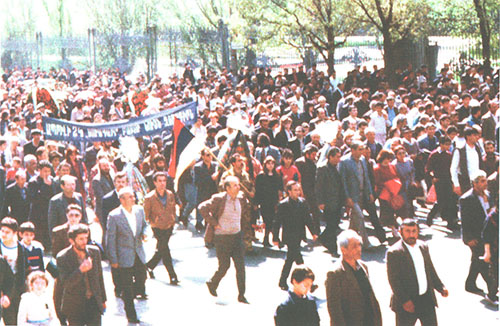
Armenian Massacres in Baku during January 13-19: Another Genocidal Act
13.01.2021
Out of the population of 1.7 million in Baku, the capital of Azerbaijan, more than 200,000 were Armenian. Typically, right from the beginning of the Karabagh Movement, the issue of the security of Armenians in Baku at that time and later was being linked to the developments of the Karabagh issue, not only by the Azerbaijani, but also the highest Soviet leadership. In a meeting of February 25, 1988, between Zori Balaian and Silva Kaputikian and Michael Gorbachev, the latter asked, “Have you thought about the fate of 207,000 Armenians living in Baku?”

Einar af Wirsén - 75
05.01.2021
Einar af Wirsén was born in 1875, in Uppsala, Sweden. He received his higher military education at the Royal Military Academy of Sweden. In 1900-1902, he has entered the Swedish Royal Army Staff College. In 1903, he has received the degree of attachment and continued his education. During 1910-1914 he has served in the General Staff. In August 1915, he was sent to the Ottoman Empire for diplomatic service. As a military attaché to the Swedish embassy, he remained in the empire until 1920, first in Constantinople, then in Sofia. As a diplomatic representative of a neutral country, Wirsén had the opportunity to travel through the empire during the war, to go to the front, to meet Turkish-German military and political figures. Wirsén’s information on the Armenian Genocide is based on the diplomat’s personal observations, German-Turkish military intelligence, as well as unofficial testimonies provided by German military personnel in the Ottoman Empire. Wirsén’s first telegrams to the Stockholm General Staff about the Armenian Genocide date back to February 1916. The attaché emphasizes that the deportation of Armenians is not the result of the governmental miscalculation or inability to control the situation, but is aimed at their destruction. Wirsén speaks of the unfriendly attitude of Turkish circles towards him due to a booklet in 1919 on the Balkans, in which he spoke negatively about the political order.
Dear visitor,
The Armenian Genocide Museum-Institute will be closed from December 30 till January 7, 2021.
Sincerely,
The Armenian Genocide Museum-Institute Foundation
| 




